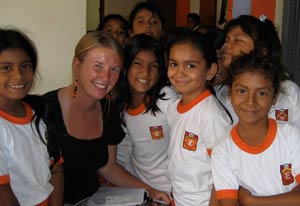Soccer and research collaborations unite cultures
August 2010 | Volume 9, Issue 4
Guest Opinion by Catherine Pastorius
"Vale, vale!" my teammate shouts as I dribble past. Another teammate, a cardiology resident I work with at the National Heart Institute in Lima, Peru, tips his invisible hat to me - a universal congratulations for scoring a hat trick in soccer.
The next day, while I am observing an open-heart procedure, the director of surgery tells me he hears I am a very good futbolista. If there is one thing that unites people from different cultures, it's soccer. And my year-long NIH Fogarty International Clinical Research Scholars fellowship taught me there's another - medicine.
As a Fogarty fellow, I am one of 30 U.S. medical students training in clinical research at sites in the developing world. Besides providing funding and mentoring, the fellowship pairs each student with a young local doctor who is pursuing a career in clinical research. I am matched with Dr. Romina Tejada, a leader in her field who is intelligent, gracious and hard-working.

Photo courtesy of Catherine Pastorius
During her year in Peru as a Fogarty Scholar,
Catherine Pastorius discovered research
collaborations -- like soccer -- are a uniting force.
Peru struggles with malnutrition and infectious diseases such as HIV, Chagas disease and tuberculosis. It is also seeing an increase in cardiovascular disease. Although HIV is the most common field of study, my interest is in cardiovascular disease. On my first day at the National Heart Institute, I heard more murmurs than I will probably hear in my entire career in the U.S.
After a long day observing open-heart surgeries and trying to get a patient with an abdominal aortic aneurism into the only functioning CT scanner in the 1,000-bed hospital, many of us trade scrubs for pinnies. We head to the soccer field. Running around under the lights, we forget our roles in the hospital.
Many mornings, I travel by bus through the heart of Lima to the public hospital. I pass neighborhoods where roads aren’t always paved, houses are made of mud bricks, and trash burns in the street. Here I learn the difference between poverty and extreme poverty. To determine household income for surveys, the assets we ask about are animals and appliances. At a local school, a teenager stepped on our bioimpedence machine and produced an “ERROR” reading because he had less than 1 percent body fat. I counseled him about eating more, especially meat. He replied that his family couldn’t afford to feed everyone every day.
On the last day of my fellowship, there was a soccer tournament. A data-entry worker invited me to play on his team. I quickly changed into shorts and joined the game that had already started. Within five minutes, I scored. A few dozen fans erupted in a roar; it was exhilarating. After the game, we had a feast and I got a lot of congratulatory kisses on the cheek.
After seven months in Peru, my Spanish had improved, I was spending a significant amount of time in the hospital seeing things that I never would see as a fourth-year medical student in the United States, I built relationships and I was playing soccer regularly.
And I learned that clinical research is very much a global field requiring the hard work and talent of an international team.
Catherine Pastorius is a fourth-year medical student at the University of Minnesota who spent much of the past year in Peru as a Fogarty International Clinical Research Scholar.
A version of this essay, Playing on a Global Field: Like soccer, medicine unites young investigators from different parts of the world, appeared in the April 2010 issue of Minnesota Medicine. © 2010 Minnesota Medical Association.
To view Adobe PDF files,
download current, free accessible plug-ins from Adobe's website.